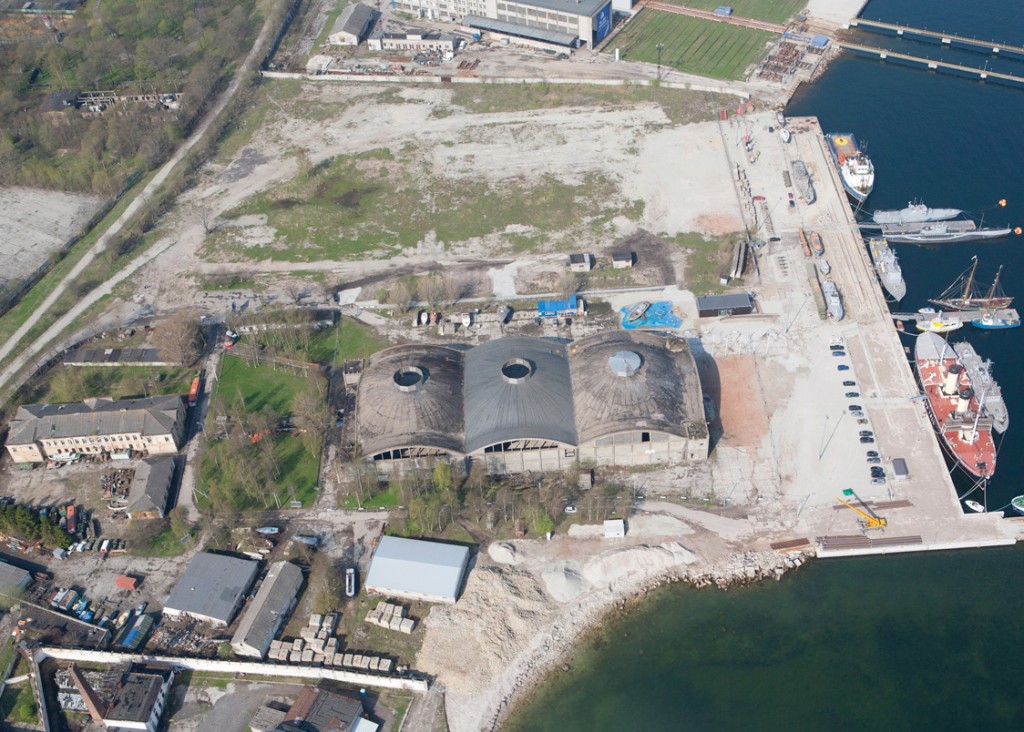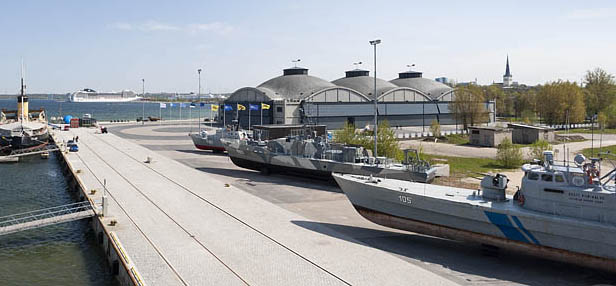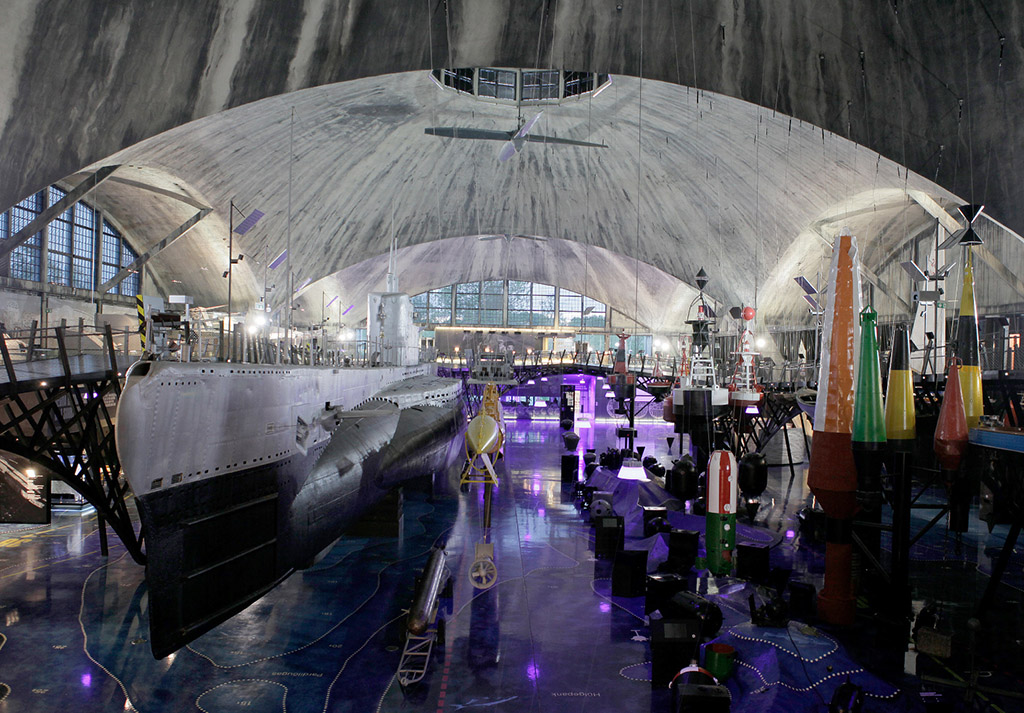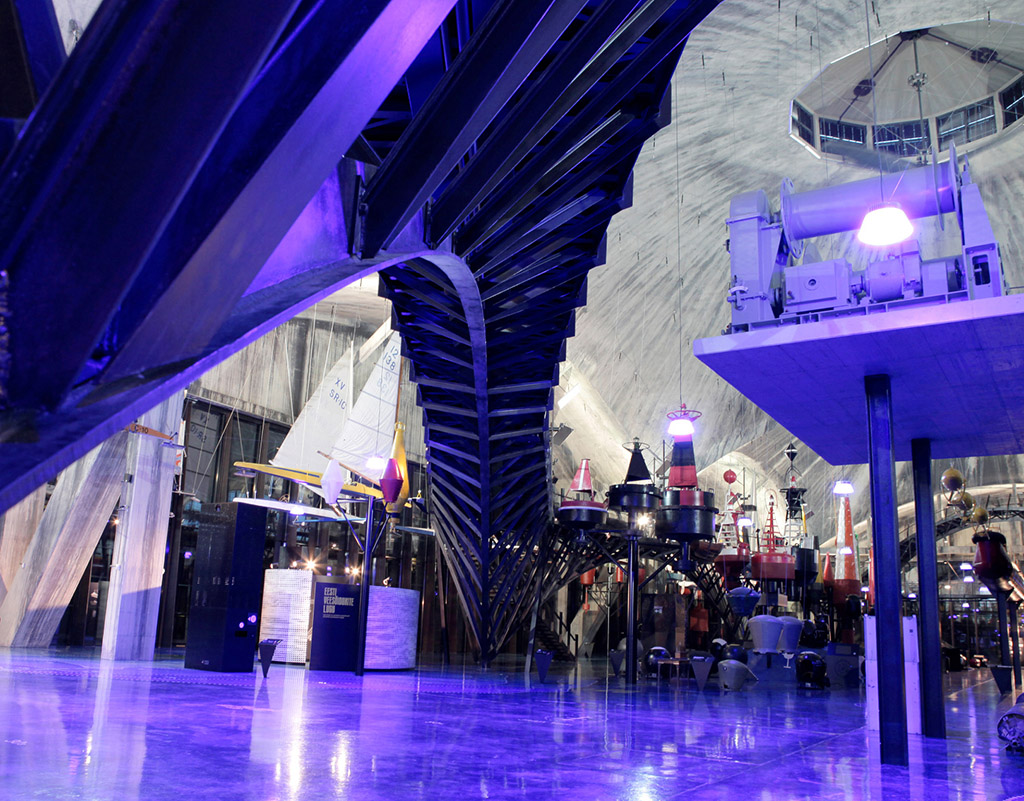The history of the Seaplane Harbour hangars goes back to the building of Peter the Great’s Naval Fortress, plans for which were drafted in 1907. Tallinn was chosen to be the central base for a defence network (to protect the St. Petersburg) in the Gulf of Finland. Taking into account the rapid development of military aviation, a plan was drawn up to build a seaplane harbour.
The hangars were commissioned by the Russian Empire and designed by a Danish engineering company Christiani & Nielsen between 1916–1917 to host the largest seaplanes of the time.
The seaplane hangars at the Tallinn Seaplane Harbour are the most important history of engineering landmark in the region. They were the first large-scale (109x36m) reinforced concrete shell structure to be built in the world. The creation of analogue structures started in the 1930s and became particularly popular in the 1950s. Therefore, the complex was thoroughly modern and twenty years ahead of its time in terms of engineering.
The hangars are unique due to their construction history, and have a high value since they are the most important engineering heritage site in the Baltic States.
They have a rectangular floor plan and comprise three concrete shell domes with structural support on a 35×35 metre grid. The domes are extremely thin; the thickness of the concrete at the top of each dome is only eight centimetres and 12 cm near the support pillars. This construction solution allowed the construction of an immense internal space, where an area measuring 35×116 m does not contain a single pillar.
During the soviet era (1940-1991) the hangars lost the roof of the light shafts and the rest of the roof was not waterproof. The overall carelessness, rainwater and icing brought the construction close to collapse by 2009, when the large-scale reconstruction started. The hangars in fact were in a terrible disrepair and some international experts considered restoration not feasible.
The reconstruction of the Seaplane Harbour Hangars (Estonian Maritime Museum) took place in 2009-2012; it was co-funded by the European Regional Development Fund. The project was led by the Museum Building Foundation (Muuseumiehituse Sihtasutus) with the main designer KOKO Architects and construction company was Nordecon. The design contained a large number of experimental solutions that had not been previously implemented in this way. Due to the project, this unique engineering landmark was saved from collapse and restored. Furthermore a large part of Estonia’s maritime cultural and technological heritage has been restored and well presented.
A site not accessible has been opened to the public, and an important step has been taken in reopening the city to the sea, in a regeneration process of a run-down neighbourhood who returned to the people its cultural heritage.
The architectural idea during the reconstruction of the building into a museum was to preserve the large hall space of the hangars as one whole unit and to keep new and old visibly separate.
The exhibition areas of the museum are divided into three levels: submarine world, the water’s surface and the airspace above the water. The exposition focuses on 19-20th century maritime technology: submarines, coastal defence, air defence, water transport etc.
The SeaplaneHarbour’s exhibition tells the story of maritime technological developments, those that took place in Estonia and those that are connected with Estonia.
The permanent exhibition houses about 225 items, including: the submarine Lembit, traditional sailing ships and modern yachts, military and border patrol vessels, anchors, and cannons, Estonian military uniforms, 14 canvases of largest that give a new and unusual view on the development of military technology.
To boost the experience of the space and enrich the viewing of the exposition a bridge was constructed that elegantly passes through the room. The hangars have new folding doors, which are closed during the daytime to keep exhibition room dark and exhibits spotlighted. The doors open just every hour for 5 minutes to flood the room with light and shift the focus to the building and concrete shells.
A large number of innovative and unique solutions were developed, in which water and special sound effects are used to enhance the museum experience. Both traditional panels and touchscreen displays are used to present the exhibits in order to read information, see pictures, watch archival footage and animations. The museum floor is a large maritime chart, based on historical maps.
At almost one hundred years old, the building located on the waterfront at the old seaplane harbour became the new home for the Estonian Maritime Museum and helps to promote the Estonian cultural heritage in the whole world.
The maritime museum, a unique building with a long history and great potential, was opened in fact in May 2012 and has rapidly become Tallinn’s most popular attraction, after the Old Town, and the most visited museum in Estonia. The Seaplane Harbour has become one of the most important places for cultural events in Tallinn (concerts, films, lectures, workshops, etc.).
The Seaplane Harbour Hangars in Tallinn, reconstructed by KOKO Architects, is as a brilliant example of a technically complicated and multi-faceted process that has transformed a historic building in a maritime museum, destined to become the driving force in the redevelopment of a neglected area of the city.
With its extensive grounds, historical hangars, and an active harbour life, the Seaplane Harbour contributes significantly to enhancing the value of the coastal areas of Tallinn. Creating a museum at the SeaplaneHarbour opens Tallinn to the sea and incorporates the sea into the urban space.
Tallinn Seaplane Harbour, Tallinn, Estonia
La storia degli hangar del Seaplane Harbour risale alla costruzione della fortezza navale di Pietro il Grande, i cui piani sono stati redatti nel 1907. Tallinn è stata scelta per essere la base centrale di un sistema di difesa (per proteggere St. Petersburg) nel Golfo della Finlandia. Tenendo conto del rapido sviluppo dell’aviazione militare, è stato elaborato un piano per la costruzione di un porto per idrovolanti.
Gli hangar sono stati commissionati dall’Impero Russo e progettati da una società di ingegneria danese Christiani & Nielsen tra il 1916-1917 per ospitare i più grandi idrovolanti del tempo. Gli hangar per idrovolanti all’interno del Seaplane Harbour di Tallin costituiscono un punto di riferimento molto importante per quanto riguarda la storia dell’ingegneria nella regione. Sono infatti le prime coperture di grandi dimensioni (109x36m) con struttura in cemento armato ad essere costruite in tutto il mondo. La creazione di strutture analoghe ha avuto inizio nel 1930 ed è divenuta particolarmente popolare nel 1950. Pertanto, il complesso è stato assolutamente innovativo e realizzato con 20 anni di anticipo rispetto ai tempi dell’ingegneria.
Gli hangar sono unici per la loro storia costruttiva, e hanno un valore elevato in quanto sono elencati tra i più importanti siti del patrimonio di ingegneria nei Paesi Baltici.
Hanno una pianta rettangolare e comprendono tre cupole con copertura in cemento con supporto strutturale a griglia di 35×35 m. Le cupole sono estremamente sottili; lo spessore del calcestruzzo nella parte superiore di ogni cupola è solo di 8 cm e di 12 cm in prossimità dei pilastri di sostegno.
Questa soluzione costruttiva ha permesso la costruzione di uno spazio interno immenso, in cui una superficie di 35×116 m non contiene un unico pilastro.
Durante l’era sovietica (1940-1991) sono andate perse le coperture dei pozzi di luce e la permeabilità del tetto. La trascuratezza generale, l’acqua piovana e la formazione di ghiaccio hanno portato la costruzione vicino al collasso nel 2009, quando è stata avviata la ricostruzione su larga scala. Gli hangar infatti si trovavano in stato di forte degrado e alcuni esperti internazionali ritennero il restauro non fattibile.
La ricostruzione del Seaplan Harbour Hangar (Museo Marittimo Estone) ha avuto luogo tra il 2009 e il 2012; è stata co-finanziata dal Fondo Europeo per lo Sviluppo Regionale. Il progetto è stato condotto dalla Museum Building Foundation (Muuseumiehituse Sihtasutus) con lo studio di progettazione KOKO Architects e con la società di costruzioni Nordecon. La proposta progettuale conteneva numerose soluzioni sperimentali che non erano stati precedentemente attuati in questo modo. Grazie al progetto, questo monumento di ingegneria unico è stato salvato dal collasso e restaurato. Inoltre gran parte del marittimo patrimonio culturale e tecnologico dell’Estonia è stato restaurato e reso fruibile.
Un sito non accessibile è stato aperto al pubblico, ed è stato compiuto un passo importante per la riapertura della città al mare, in un processo di rigenerazione di un quartiere degradato che ha restituito alla gente il suo patrimonio culturale.
L’idea architettonica durante la ricostruzione dell’edificio in un museo è stata quella di preservare il grande spazio di ingresso degli hangar come un’unità intera e mantenere il vecchio e il nuovo visibilmente separati.
Le aree espositive del museo sono suddivise in tre livelli: mondo sottomarino, superficie dell’acqua e lo spazio aereo sopra l’acqua. L’esposizione si concentra sulla tecnologia marittima del XIX e del XX secolo: sottomarini, difesa costiera, difesa aerea, trasporto di acqua, etc.
L’esposizione del Seaplane Harbour racconta la storia degli sviluppi tecnologici marittimi, quelli che hanno avuto luogo in Estonia e quelli che sono collegati con l’Estonia.
L’esposizione permanente ospita circa 225 oggetti, tra cui: il sottomarino Lembit, velieri tradizionali e yacht moderni, navi militari e di pattugliamento delle frontiere, ancore e cannoni, uniformi militari estoni, 14 tele separate di grandi dipinti che restituiscono una nuova e insolita immagine dello sviluppo della tecnologia militare.
Per incrementare l’esperienza dello spazio e arricchire la visione dell’esposizione è stato costruito un ponte che attraversa con eleganza la sala. Gli hangar sono dotati di porte a soffietto, che sono chiusi durante il giorno per mantenere buia la sala espositiva e illuminati gli oggetti in mostra. Le porte vengono aperte ogni ora per 5 minuti in modo da inondare la stanza di luce e spostare l’attenzione sulla struttura costruttiva e sulle copertura in calcestruzzo.
Sono state proposte numerose soluzioni innovative ed uniche, in cui sono stati utilizzati l’acqua ed effetti sonori speciali in modo da migliorare l’esperienza museale. Sono stati utilizzati pannelli tradizionali e display touchscreen per presentare le esposizioni in modo da poter leggere informazioni, vedere immagini, guardare filmati d’archivio e animazioni. Il pavimento del museo è una grande carta marittima, che fa riferimento alle mappe storiche.
A quasi 100 anni di età, l’edificio situato sul lungomare presso il vecchio porto per idrovolanti è diventato la nuova sede dell’Estonian Maritime Museum (Museo Marittimo Estone) e contribuisce a promuovere il patrimonio culturale estone in tutto il mondo.
Il museo marittimo, un edificio unico con una lunga storia e un grande potenziale, è stato inaugurato infatti nel maggio 2012 ed è rapidamente diventato l’attrazione più famosa di Tallinn, dopo il centro storico, e il museo più visitato in Estonia. Il Seaplane Harbour è diventato uno dei luoghi principali per gli eventi culturali a Tallinn (concerti, film, conferenze, laboratori, etc.).
Il Seaplane Harbour Hangar a Tallinn, ricostruito da KOKO Architects, è un brillante esempio di un processo tecnicamente complicato e articolato che ha trasformato uno storico edificio in un museo marittimo, destinato a diventare l’elemento trainante nella riqualificazione di un’area dismessa della città.
Con le sue ampie superfici, gli hangar storici e una vita portuale attiva, il Seaplane Harbour contribuisce in modo significativo alla valorizzazione delle aree costiere di Tallinn. La creazione di un museo nel Seaplane Harbour ha aperto Tallin al mare e ha integrato il mare nello spazio urbano.



